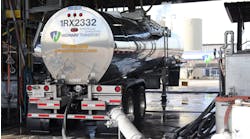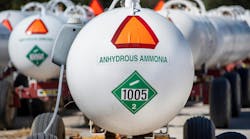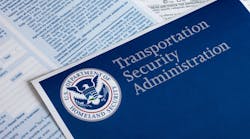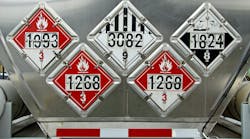The National Highway Traffic Safety Administration (NHTSA) is considering the adoption of a new Federal Motor Vehicle Safety Standard (FMVSS) that would require all vehicles with a gross vehicle weight rating (GVWR) greater than 10,000 lbs. to equip automatic emergency braking (AEB) systems.
The notice of proposed rulemaking (NPRM), which includes amending FMVSS No. 136, reached the Federal Register on July 5, and since then nearly 700 comments have poured in both for and against the rule. In fact, NHTSA received more than 100 comments in the seven days before the Sept. 5 deadline, including from National Tank Truck Carriers, American Trucking Associations (ATA), the Truckload Carriers Association (TCA), the Commercial Vehicle Safety Alliance (CVSA), and NTEA – The Association for the Work Truck Industry.
If adopted, the requirement would take effect as soon as three years from the date the final rule is published.
“Safety is at the heart of everything NTTC members do every day hauling bulk commodities across the United States, often containing cargoes classified as hazardous materials,” Will Lusk, NTTC director of education and government relations, wrote in the association’s comments. “Therefore, NTTC supports the agency’s initiative to adopt a new Federal Motor Vehicle Safety Standard (FMVSS) to require automatic emergency braking (AEB) systems on heavy vehicles.
“NTTC also supports the NHTSA proposal to amend FMVSS No. 136 to require nearly all heavy vehicles to have an electronic stability control system that meets the equipment requirements, general system operational capability requirements, and malfunction detection requirements of FMVSS No. 136. Further, NTTC in general supports Federal Motor Carrier Safety Regulations being updated to require the electronic stability control and AEB systems to be on during vehicle operation.”
NTTC also applauded NHTSA and the Federal Motor Carrier Safety Administration (FMCSA) determinations not to propose AEB retrofitting requirements for existing vehicles and said it isn’t concerned with AEB false activations, assuming sensors are properly installed. However, the association indicated it opposed the authorization of manually operated AEB deactivation switches. “Tank truck carriers cannot foresee why a driver would want to deactivate AEB when operating their commercial vehicle,” NTTC said.
“Since AEBs are designed to protect the driver and the motoring public, NTTC maintains that such systems should be active whenever a heavy-duty truck is in operation.”
ATA, TCA, CVSA, and NTEA also generally supported an AEB requirement in their comments, but ATA and CVSA also noted several challenges with the proposed implementation.
“ATA policy supports a regulatory approach for automatic emergency braking (AEB) on all classes of new vehicles, as well as regulatory approaches to safety technologies that follow technological maturity and cost/benefit data,” Dan Horvath, vice president of safety policy, and Kevin Grove, director of safety and technology policy, wrote in their 17-page letter. “While ATA supports NHTSA and FMCSA’s efforts to mandate AEB on classes 3-8, the proposed rule put forth by NHTSA and FMCSA in the Notice of Proposed Rulemaking (NPRM) NHTSA-2023-0023 and FMCSA-2022-0171 contains a number of provisions that do not reflect the reality of AEB, particularly within medium duty (Classes 3-6).
“Most importantly, the NPRM presents AEB as an immediate panacea for preventing rear-end crashes. This is reflected in test procedures and minimum performance requirements that mischaracterize the benefits of AEB, and timelines for medium duty implementation that do not reflect the immaturity of ESC and AEB in that sector and would not allow for proper development and integration of the technology.”
CVSA, in its 14-page comments, emphasized the difference between mitigation and prevention technology.
“In the joint proposal, NHTSA and FMCSA characterize AEB as crash prevention technology,” noted Collin B. Mooney, CVSA executive director. “This thought is reflected in the minimum test procedures and minimum performance requirements that do not allow for vehicle contact at high speeds. However, in speaking with the developers of AEB and in conversations with other stakeholders, the consensus is that AEB is intended to serve as crash mitigation technology. Forward collision warning (FCW) and AEB are designed to alert the driver to a potential crash and then to help the driver respond if necessary. It is not designed to prevent crashes.
“As noted by other stakeholders, AEB is intended to be a tool to help reduce the risk associated with collisions through speed reduction. Many of the testing procedures and performance standards appear to be crafted for AEB as a prevention tool, rather than a mitigation tool, and this disconnect must be addressed.”










